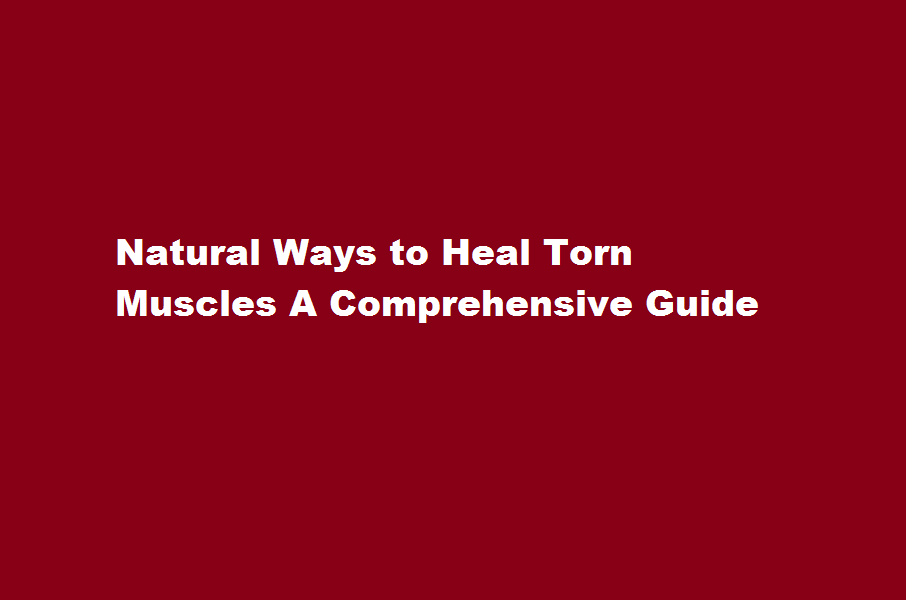Natural Ways to Heal Torn Muscles A Comprehensive Guide
4 min read
Introduction
Muscle tears, also known as strains, are common injuries that can occur during physical activity. Whether you’re an athlete or someone who enjoys exercising, a torn muscle can be debilitating. This article will explore natural methods to help speed up the healing process and restore strength to the injured muscle. While these suggestions can be useful, it’s important to consult a healthcare professional for an accurate diagnosis and personalised treatment plan.
Understanding Torn Muscles
A torn muscle happens when muscle fibres stretch beyond their limits, resulting in microscopic or visible tears. Symptoms include pain, swelling, bruising, and difficulty moving the affected area. Treating a torn muscle involves following the RICE protocol: Rest, Ice, Compression, and Elevation. However, there are additional natural remedies that can enhance the healing process and alleviate discomfort.
Gentle Movement and Rest
It’s crucial to strike a balance between rest and gentle movement when healing a torn muscle. Complete immobilisation can hinder recovery, leading to muscle stiffness and weakness. Gradually introduce controlled movements within your pain tolerance to improve circulation and promote healing. Avoid strenuous activities that may aggravate the injury. Rest is still essential during the initial stages to allow the body to repair itself, so listen to your body’s signals and adjust your activity level accordingly.
Apply Cold and Heat Therapy
Applying ice packs or cold compresses to the injured area for 15-20 minutes several times a day can help reduce pain and inflammation. Cold therapy constricts blood vessels, preventing excessive swelling. After 48-72 hours, switch to heat therapy, such as warm compresses or a warm bath, to promote blood flow, relax muscles, and accelerate healing. Alternate between cold and heat treatments for optimal results.
Gentle Stretching and Strengthening Exercises
Once the initial acute phase has passed, gentle stretching and strengthening exercises can aid in restoring flexibility and muscle function. Gradually introduce range-of-motion exercises that target the affected muscle group to prevent muscle atrophy and improve mobility. Remember to perform these exercises under the guidance of a healthcare professional or a qualified trainer to ensure proper technique and avoid further injury.
Supportive Nutrition and Hydration
Proper nutrition plays a vital role in the healing process. Consume a well-balanced diet rich in lean proteins, whole grains, fruits, and vegetables to provide essential nutrients for tissue repair. Foods high in vitamin C, vitamin D, and omega-3 fatty acids have anti-inflammatory properties that can aid in healing. Staying well-hydrated is also crucial for maintaining optimal tissue function and promoting the transport of nutrients to the injured area.
Restorative Sleep and Stress Management
Adequate restorative sleep is essential for healing torn muscles. During sleep, the body repairs damaged tissues and replenishes energy stores. Establish a regular sleep schedule and create a relaxing bedtime routine to ensure quality rest. Additionally, managing stress levels is crucial, as chronic stress can impair the body’s healing processes. Engage in stress-relieving activities such as meditation, deep breathing exercises, or yoga to promote relaxation and support the healing journey.
Frequently Asked Questions
How long does a torn muscle take to repair?
Muscle tears will heal within six weeks unless they are very severe. Non-structural muscle strains can recover even sooner as they are usually just muscle spasm. The first few weeks are a vulnerable time for your body as it repairs. The risk of re-injury during this period is between 40 and 70% higher than normal.
Can muscle tears heal without surgery?
A large portion of muscle injuries, even many tears, can be treated conservatively without the need for surgery. This includes rest, ice, compression, elevation, over-the-counter medication and physical therapy. However, in some cases especially a completely torn muscle, patients require surgical repair.
Conclusion
Healing a torn muscle takes time, patience, and a multifaceted approach. By combining gentle movement, appropriate rest, cold and heat therapy, targeted exercises, proper nutrition, restorative sleep, and stress management, you can optimise your body’s natural healing mechanisms and expedite the recovery process. Always consult with a healthcare professional for a comprehensive diagnosis and treatment plan.
Read Also : Overcoming Sleep Paralysis A Guide to Reclaiming Restful Nights






